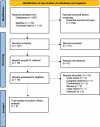Routine closed-suction drainage reduces seromas following totally extraperitoneal (TEP) inguinal hernia repair: A meta-analysis
- PMID: 38489721
- PMCID: PMC10939558
- DOI: 10.1097/MD.0000000000037412
Routine closed-suction drainage reduces seromas following totally extraperitoneal (TEP) inguinal hernia repair: A meta-analysis
Abstract
Background: The value of prophylactic closed-suction drainage in totally extraperitoneal inguinal hernia repair (TEP) is still a matter of controversy. We conducted a meta-analysis of studies examining postoperative seroma rates in patients with or without routine placement of closed-suction drainage tubes.
Methods: A systematic literature search was conducted for trials comparing the outcome of TEP with or without routine drainage placement. Data regarding postoperative outcomes were extracted and compared by meta-analysis. The odds ratio and standardized mean differences with 95% confidence intervals were calculated.
Results: Four studies were identified, involving a total of 1626 cases (Drain: n = 1251, no Drain: n = 375). There was a statistically significant difference noted between the 2 groups regarding postoperative seroma formation favoring the Drain group (odds ratio = 0.12; 95% confidence intervals [0.05, 0.29]; P < .001; 4 studies; I2 = 72%). For the remaining secondary endpoints postoperative urinary retention, recurrence, mesh infection and in-hospital length of stay no statistically significant difference was noted between the 2 study groups.
Conclusion: Current evidence suggests that patients who underwent TEP with routine closed-suction drain placement developed significantly fewer seromas without any additional morbidity or prolongation of in-hospital stay.
Copyright © 2024 the Author(s). Published by Wolters Kluwer Health, Inc.
Conflict of interest statement
The authors have no conflicts of interest to disclose.
Figures
References
-
- Jähne J. Surgery of inguinal hernia. Chirurg. 2001;72:456–69. - PubMed
-
- Dulucq J. Treatment of inguinal hernia by insertion of a subperitoneal patch under pre-peritoneoscopy. Chirurgie. 1992;118:83–5. - PubMed
-
- Liu JW, Chen KJ, Xu XH, et al. . Does the use of monopolar energy as the preferred mode of dissection effectively reduce seroma formation in laparoscopic total extra peritoneal hernioplasty? A prospective double-blinded randomized control trial. Hernia. 2020;24:821–9. - PubMed
-
- Krishna A, Misra M, Bansal V, et al. . Laparoscopic inguinal hernia repair: transabdominal preperitoneal (TAPP) versus totally extraperitoneal (TEP) approach: a prospective randomized controlled trial. Surg Endosc. 2012;26:639–49. - PubMed
Publication types
MeSH terms
LinkOut - more resources
Full Text Sources
Medical








